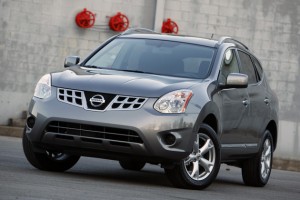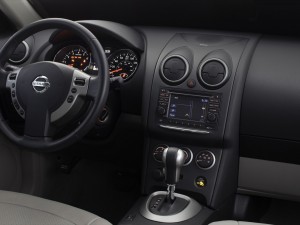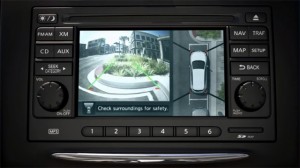In 2008, when the Rogue was launched, it was a kind of poor-man’s BMW X3. It had more power and better performance – especially in the handling department – than other compact $20k-ish crossover SUVs like the more utilitarian-minded Honda CR-V and Toyota RAV4. It was sleek and slick, too – something you couldn’t say about the conventionally crossover-looking competition. For the cash, there was nothing else quite like it. 
All of which made it very appealing.
Since then, competitors have come online, including most notably the new Kia Sportage, whose starting price of $18,500 undercuts the Rogue’s base price of $21,850 by three thousand three hundred fifty hard-to-ignore dollars.
But the Rogue’s still a contender on the merits – including the strongest performance for the dollar (more on this below). It’s also got some things going for it you can’t get in other vehicles of this type for any money – such as an available 360-degree bird’s-eye-view camera system. And there’s less in the way of suffocating “safety” gewgaws like the annoying belt-minder buzzer that virtually every new vehicle – other than Nissan vehicles – now comes with.
So, take a look. It may not be the only genuinely sporty compact crossover on the market anymore. But it’s still one of the best you’ll find for under $22k to start.
WHAT IT IS
The Rogue is a sportier-than-most compact crossover that looks a lot like a scaled-down Murano, its bigger brother in Nissan’s model lineup – but which shares much of its mechanical underthings with the Sentra sedan – including its engine.
Prices start at $21,850 for the base/front-wheel-drive S model and top out at $25,660 for an all-wheel-drive equipped SV.
The Rogue’s most direct competition is the $18,500-$26,900 Kia Sportage but other vehicles in this general size/type/price range include the $21,895- $26,845 Honda CR-V, the $20,595-$29,895 Subaru Forester and (higher up the food chain) the $22,840-$35,930 to start VW Tiguan.
WHAT’S NEW FOR 2012
There’s a luxury-minded Special Edition package that includes a 4.3 inch LCD display and Bose premium audio system with satellite radio, privacy glass and special 16 inch alloy wheels. Also new is the available “bird’s eye” 360 degree panorama camera, which shows you what’s around you on all sides at the same time. 
WHAT’S GOOD
Still much more fun to drive than the typical compact crossover.
Standard 2.5 liter, 170 hp engine.
Quicker than the standard-engined Sportage.
Much quicker than a CR-V.
Top-of-the-line AWD Rogue SV costs less than top-of-the-line competitor models, including the $26,900 Kia Sportage SX.
Much less than a top-of-the-line Forester or Tiguan.
Unique features and equipment, such as the bird’s-eye camera system.
More ground clearance than others in this segment.
WHAT’S NOT SO GOOD
Similarly sporty Kia Sportage costs much less to start.
CR-V has a bit more more power (180 hp) and a lot more room for cargo (73 cubic feet vs. 58 for the Rogue).
No turbo engine or V-6 upgrade (as in Sportage, Tiguan or Toyota RAV4).
Not everyone will like the Rogue’s mandatory Continuously Variable (CVT) automatic transmission.
Minimal towing capability (1,000 lbs. max).
UNDER THE HOOD
The Rogue is powered by a 2.5 liter, 170 hp four-cylinder engine teamed up with a Continuously Variable (CVT) automatic. There is no optional engine or transmission. You can, however, choose front-wheel-drive or all-wheel-drive. 
Back in ’08, the Rogue had one of the strongest engines you could get in small crossover. Not just the strongest standard engine, either.
Today, the Rogue’s engine is still among the stronger engines in this class, but no longer the strongest available. The new Kia Sportage – Rogue’s most direct competition – comes standard with a 176 hp engine. And you can upgrade to a 260 hp turbo engine.
Also, the Kia offers a six-speed manual transmission.
The Rogue’s acceleration (0-60 in about 8.5 seconds) is still pretty solid, though, relative to power-and-price-equivalent competitors like the Honda CR-V, which needs almost 10 seconds to get to 60 MPH. The Nissan is also quicker than the base model Kia Sportage, which (surprisingly) takes about 9.4 seconds to reach 60. Looking at the specs – including the curb weight of the two vehicles – you’d expect the Sportage to be at least as quick as the Rogue, if not quicker. It has a bit more power and it weighs about 100 pounds less. Maybe the Rogue’s power output is under-rated. Maybe the Kia’s is over-rated. Or maybe the Rogue is just geared more aggressively.
Regardless, the numbers speak for themselves.
The Sportage can outperform the Rogue. But only if you buy the $26k Sportage SX, equipped with the turbo engine. This version of the Sportage is priced about $5,000 more than the base version of the Rogue – and about $2k more than a top-of-the-line Rogue SV.
For the coin, the Rogue is still the best performer here.
Gas mileage is 23 city, 28 highway (FWD), also very good for the segment. The Kia Sportage is slightly behind, city-mileage-wise (21 MPG) and just slightly better on the highway (29 MPG). Honda’s CR-V clocks in at 21/28 and the Subaru Forester at 21/27.
Towing capability, on the other hand, is modest – just 1,000 lbs. max. A Honda CR-V can handle 1,500 lbs and you can find crossovers in this class that can pull 3,500 lbs.
Even a direct (similarly sport-minded) competitor like the Sportage can manage 2,000 lbs.
The Rogue is built off of the same platform as the current Sentra sedan – and uses the same basic engine that comes in the performance-tuned Sentra SE-R.
The difference is the Rogue weighs in at a husky 3,276 lbs. while the Sentra SE-R weighs only 3,078 lbs.
Also, the Sentra SE-R is available with a six speed manual transmission while the Rogue comes only with the CVT automatic.
The net result is that the Rogue is eager, but a bit overweight and (in my opinion) just a bit underpowered.
Under hard acceleration it feels a lot like a Sentra with too many people on board – and too much stuff in the trunk.
What’s needed is more power, especially in view of the fact that competitors like the Sportage can be had with much more powerful optional engines.
I was hoping that Nissan would slip the Sentra SE-R Spec V’s 200 hp version of the 2.5 liter engine into the lineup for 2012. Or at least offer the option of a manual transmission rather than the take-it-or-leave-it CVT.
Either – better yet, both – would make the Rogue a lot more roguish.
Point of clarification: CVTs were designed chiefly for fuel-economy reasons. That’s the main reason why so many car companies are pushing CVTs. A relatively small uptick in the EPA averages is a big deal for the automakers, who are faced with having to meet ever-stricter federal Corporate Average Fuel Economy (CAFE) requirements – which are about to escalate to 35.5 MPG, average, in 2016.
Even a seemingly negligible improvement of 1-2 MPGs overall made possible by going with a CVT vs. a conventional automatic (or even a manual) is a major sell for the car companies.
Even if it’s not the ideal set-up for the people actually buying the cars.
In a borderline heavy/could-use-more-power vehicle like the Rogue, a CVT sometimes gives the impression the engine’s being thrashed. Give it more than about half pedal and the engine RPMs shoot up to 4,000 RPMs or more – and stay there until you back off the gas. Much noise is produced, but not all that much acceleration.
This is how CVTs work. They maximize efficiency by keeping the engine constantly at the right spot in the powerband (RPM range) whereas a conventional automatic is constantly “stepping” up or down to match the gearing to the road speed/load on the engine.
The shift-less quality of CVTs is a plus in some respects. There’s no coffee-spilling snap-and-back as the car accelerates, because there are no gears to shift. Just a continuous forward surge. But the downside is the engine can feel (and sound) like it’s being over-revved and working too hard.
That’s the Rogue’s chief weakness as I see it.
Otherwise, it’s extremely agile – with excellent steering and quicker reflexes than its main rivals. The Kia Sportage is the only other sport-minded crossover that handles and reacts as athletically. But the Kia – when equipped with its base engine – is noticeably more lethargic in terms of get up and go.
If you like the appearance of the Murano – Nissan’s upscale large crossover – you’ll like the way the Rogue looks, too. Very similar overall shape – just on a smaller scale.
Like its big brother, it has a rakish roofline, hunky-looking side panels with pontoon-like fender flares – and can be ordered with fairly large (18 inch) wheels, which enhances its aggressive stance. The front end is toothsome, with a wide-mouthed grille and fist-sized chromed “Nissan” badge in the center. The top edges of the four doors sit lower than the front windshield and cant upward slightly to the point where they meet the third (fixed) quarter window near the tailgate.
The dash layout is serious-looking but not severe-looking and all the controls are very tactile and functional – most especially the large rotary knobs for controlling the AC, heater and fan speed. 
On the downside, form sacrifices function – at least in terms of available cargo space relative to competitors like the Honda CR-V and Toyota RAV4.
The Rogue has about 58 cubic feet of cargo space with its second row seats folded down. That is a lot less than the available space in the CR-V and the Toyota RAV4 – both of which have about 73 cubic feet of total capacity. The Kia Sportage has 54.6 cubic feet of total cargo capacity.
The Rogue’s rear seats are a bit cramped, too. Legroom for second-row occupants is 35.3 inches vs. 37.9 in the Kia, 38.5 in the CR-V and 38.3 in the RAV4.
On the other hand, the Rogue is more alive-feeling than functional but personality-free crossovers like the CR-V a RAV4.
And there’s a final practical plus: The Rogue’s got more ground clearance than its competition – including the Sportage. Not just a little more, either. It sits 8.3 inches off the ground vs. 6.8 inches for the Sportage, 6.7 for the CR-V and 7.5 for the RAV4.
That ought to help in the snow, especially if the snow’s not been plowed yet.
All-wheel-drive (and four-wheel-drive) are great but if the car rides up on packed snow, it’s going to get stuck, regardless. 
The Rogue’s extra inch or so of clearance could be the difference between getting there – and getting out your shovel.
THE REST
Base S models come well-equipped with standard AC, most power options (including keyless entry) and a nice stereo with MP3 jack and CD player.
A small but nice touch worth mentioning is the cargo area’s large once-piece mat, which has a rubberized underside. Flip it over and you’ve got a safe place to let the dog ride. The Rogue’s cabin also features a large center console storage cubby and an even larger glovebox, along with clever underseat storage trays. 
The optional bird’s-eye camera system is extremely trick. Activate it via the console-mounted switch and a view from above the vehicle showing everything around it is displayed on the LCD monitor. This is a much more sophisticated – and useful – system than the typical back-up camera that only shows the area behind the rear bumper. With the Nissan system, you can see the curb to your right and the trees to your left as well as whatever’s behind you – all at the same time and in real time. I’m not sure how it works, but I can tell you it works really well.
Also: Nissan is one of the very few automakers that hasn’t yet caved to politically correct pressures and fitted its cars with an annoying “belt minder” buzzer that harasses you if you or your passengers haven’t immediately buckled-up for safety – even if all you’re doing is trundling down the driveway to the mailbox.
Just a red light on the dash that blinks at you.
Silently.
THE BOTTOM LINE
There are challengers now than there were back in ’08, but for the coin, the Rogue is still a lot of fun for the money.
All it needs to live up to its name is a bit more power under the hood – and perhaps another pedal for your feet.
Throw it in the Woods?












My wife was looking for an AWD vehicle something like the Subaru Outback or Forrester. She drove them both and couldn’t see out to her satisfaction. She drove the Rogue and immediately loved it, could see out and it handles superbly. For an AWD I wanted high ground clearance and the Rogue has it, much more than the competition. After finding out about the rear camera, she had to have that, it turned out to be an absolutely must have. She had a van and was always very nervous about backing up with it. I inherited the van.
I test drove a ’14 Rogue Select – S with AWD. The other day. First time ever driving a CVT, and it was as described in the article. I stomped on the gas from a standstill, and the engine revs shot up to 6000. I was waiting for some kind of shift (it never came) then realized I was going 80mph! I then backed off the gas and sensed some type of shift. (But that was just me letting off the gas). The CVT does lug around at low speeds, trying to get the best mpgs.
I wonder about the longevity of the CVT’s, as Nissan went thru a rough spat on them, with after-warranty consumer complaints/repairs. They extended the warranty on CVT’s to 120k miles on certified used cars, but on the new ones, the warranty on the CVT is the same as the rest of the powertrain (6yr/60k miles)
I found the view out of the rearview mirror a little poor. (Looks like your looking thru a tunnel) and the shoulder belt for the middle back seat cuts thru your vista.